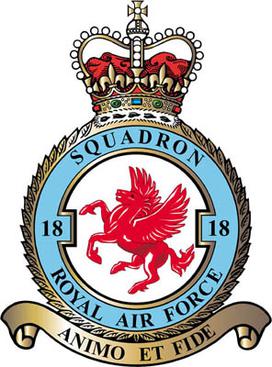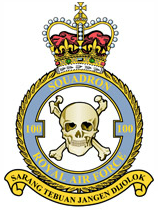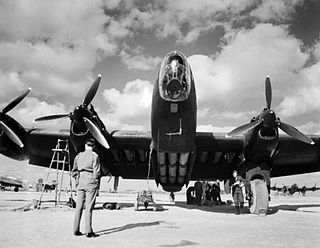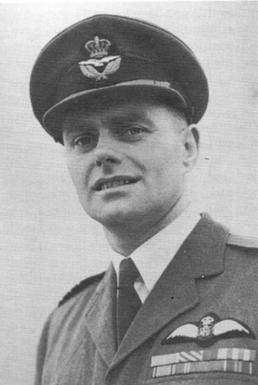
The "V bombers" were the Royal Air Force (RAF) aircraft during the 1950s and 1960s that comprised the United Kingdom's strategic nuclear strike force known officially as the V force or Bomber Command Main Force. The three models of strategic bomber, known collectively as the V class, were the Vickers Valiant, which first flew in 1951 and entered service in 1955; the Avro Vulcan, which first flew in 1952 and entered service in 1956; and the Handley Page Victor, which first flew in 1952 and entered service in 1957. The V Bomber force reached its peak in June 1964 with 50 Valiants, 70 Vulcans and 39 Victors in service.

The Vickers Valiant was a British high-altitude jet bomber designed to carry nuclear weapons, and in the 1950s and 1960s was part of the Royal Air Force's "V bomber" strategic deterrent force. It was developed by Vickers-Armstrongs in response to Specification B.35/46 issued by the Air Ministry for a nuclear-armed jet-powered bomber. The Valiant was the first of the V bombers to become operational, and was followed by the Handley Page Victor and the Avro Vulcan. The Valiant was the only V bomber to have dropped live nuclear weapons.

Operation Grapple was a set of four series of British nuclear weapons tests of early atomic bombs and hydrogen bombs carried out in 1957 and 1958 at Malden Island and Kiritimati in the Gilbert and Ellice Islands in the Pacific Ocean as part of the British hydrogen bomb programme. Nine nuclear explosions were initiated, culminating in the United Kingdom becoming the third recognised possessor of thermonuclear weapons, and the restoration of the nuclear Special Relationship with the United States in the form of the 1958 US–UK Mutual Defence Agreement.

The Avro Type 694 Lincoln is a British four-engined heavy bomber, which first flew on 9 June 1944. Developed from the Avro Lancaster, the first Lincoln variants were initially known as the Lancaster IV and V; these were renamed Lincoln I and II. It was the last piston-engined bomber operated by the Royal Air Force (RAF).

The Vickers Wellesley was a medium bomber that was designed and produced by the British aircraft manufacturer Vickers-Armstrongs at Brooklands near Weybridge, Surrey. It was one of two aircraft to be named after Arthur Wellesley, 1st Duke of Wellington, the other being the Vickers Wellington.
No. 1321 Bomber (Defence) Training Flight RAF was first formed at RAF Bottesford on 1 September 1944 as a fighter affiliation unit to train bomber crews from No. 5 Group Bomber Command how to defend their aircraft. The Flight was disbanded two months later on 1 November 1944 and absorbed by the units they trained before, 1668 Heavy Conversion Unit and 1669 Heavy Conversion Unit.

Blue Danube was the first operational British nuclear weapon. It also went by a variety of other names, including Smallboy, the Mk.1 Atom Bomb, Special Bomb and OR.1001, a reference to the Operational Requirement it was built to fill.

No. 18 Squadron of the Royal Air Force operates the Boeing Chinook from RAF Odiham. Owing to its heritage as a bomber squadron, it is also known as No. 18 (B) Squadron.

Number 100 Squadron is a former Royal Air Force squadron. It last operated the British Aerospace Hawk T1, providing 'aggressor' aircraft for air combat training from RAF Leeming in North Yorkshire, UK.

No. 148 Squadron of the Royal Air Force has been part of the RAF since the First World War.
No. 90 Squadron RAF is a squadron of the Royal Air Force.

No. 543 Squadron RAF was a photographic reconnaissance squadron of the Royal Air Force, active in two periods between 1942 and 1974.

Group Captain Kenneth Gilbert Hubbard was the pilot of an RAF Vickers Valiant bomber which dropped Britain's first live thermonuclear weapon (H-Bomb) in Operation Grapple in the Central Pacific Ocean in May 1957.
Number 76 Squadron was a squadron of the Royal Air Force. It was formed during World War I as a home defence fighter squadron and in its second incarnation during World War II flew as a bomber squadron, first as an operational training unit and later as an active bomber squadron. With the end of the war the squadron converted to the role of transport squadron, to be reactivated shortly in the bomber role during the 1950s. From 2007 to 2011, it was a training unit, equipped with the Short Tucano at RAF Linton-on-Ouse.
Number 58 Squadron was a squadron of the Royal Air Force.
No. 199 Squadron was a Royal Air Force aircraft squadron that operated during the Second World War and later in the 1950s as a radar countermeasures squadron.

The British hydrogen bomb programme was the ultimately successful British effort to develop hydrogen bombs between 1952 and 1958. During the early part of the Second World War, Britain had a nuclear weapons project, codenamed Tube Alloys. At the Quebec Conference in August 1943, British prime minister Winston Churchill and United States president Franklin Roosevelt signed the Quebec Agreement, merging Tube Alloys into the American Manhattan Project, in which many of Britain's top scientists participated. The British government trusted that America would share nuclear technology, which it considered to be a joint discovery, but the United States Atomic Energy Act of 1946 ended technical cooperation. Fearing a resurgence of American isolationism, and the loss of Britain's great power status, the British government resumed its own development effort, which was codenamed "High Explosive Research".

Air Vice-Marshal Wilfrid Ewart Oulton, was an officer in the Royal Air Force. During the Second World War he was credited with sinking three German U-boats—U-463, U-663, and U-563—in one month while serving in RAF Coastal Command. He was in charge of the British nuclear tests of hydrogen bombs in the Pacific Ocean in Operation Grapple in 1957.

No. 1340 Flight RAF was a flight of the Royal Air Force. In its first formation in India it was equipped with Vultee Vengeance Mk. IIIs and a single North American Harvard. In its second formation in Kenya it flew Harvards built under licence in Canada by Noorduyn.
Squadron Leader Edwin James George "Ted" Flavell was the pilot of the No. 49 Squadron RAF Vickers Valiant bomber which dropped Britain's first live atomic bomb during Operation Buffalo at Maralinga, South Australia, on 11 October 1956.

















